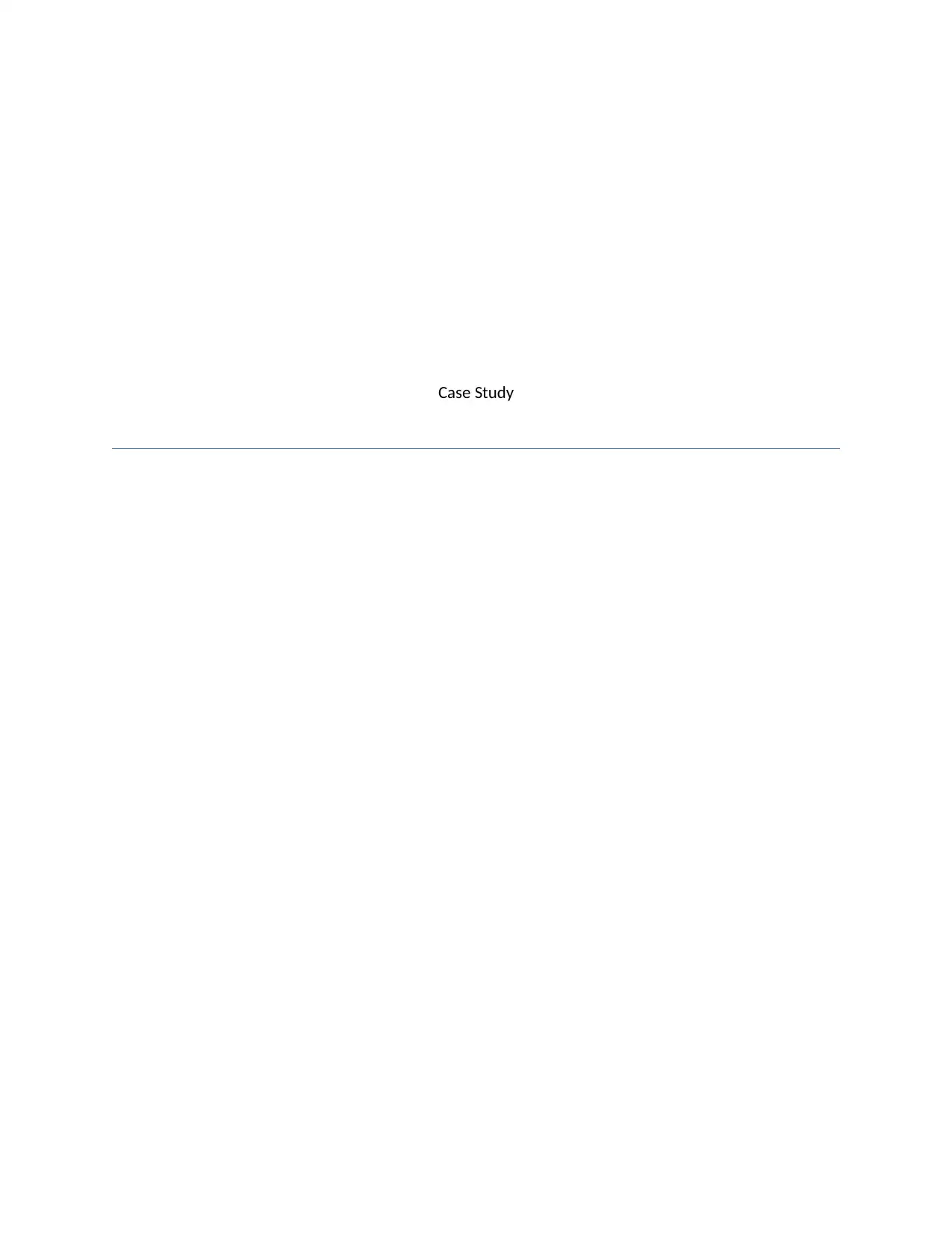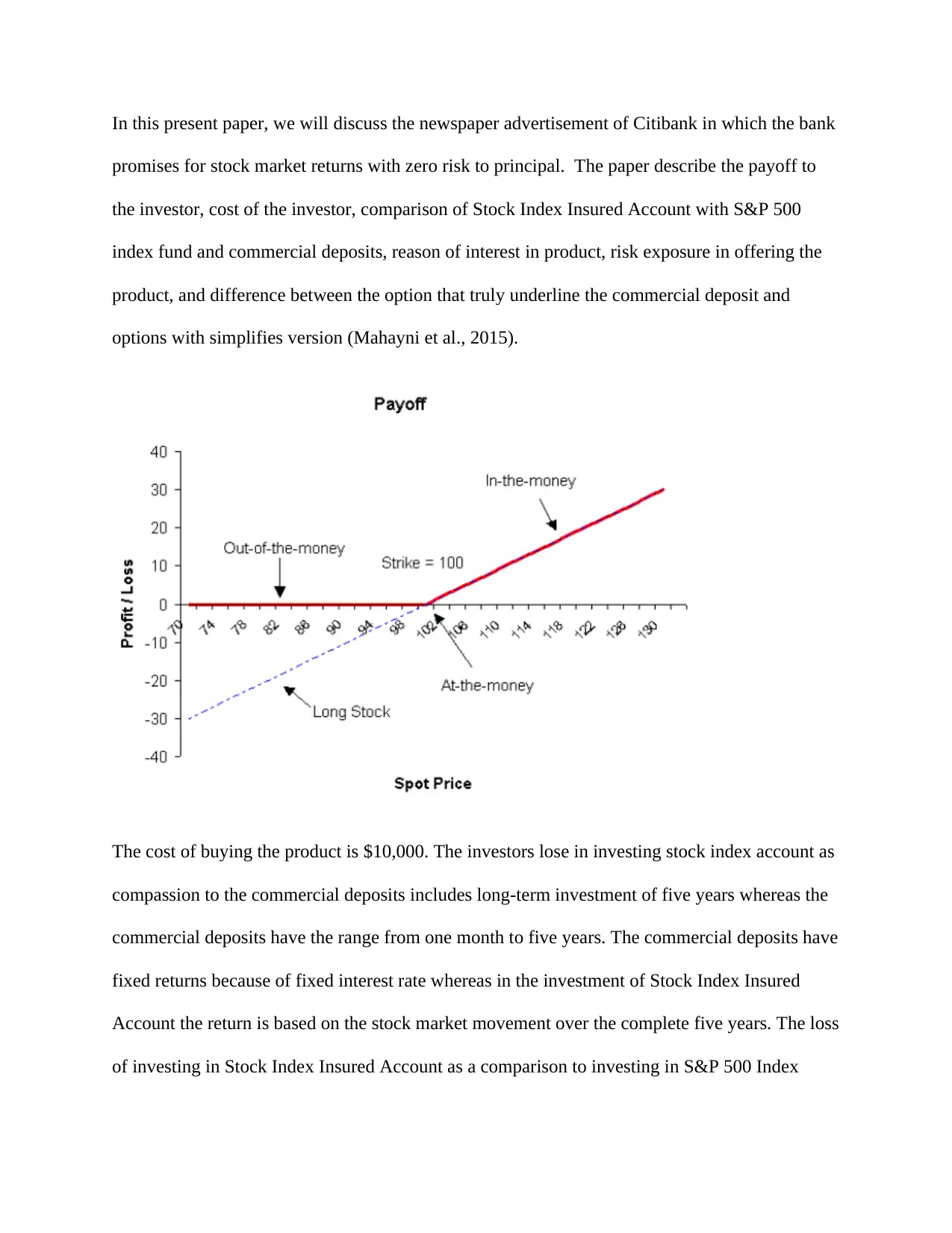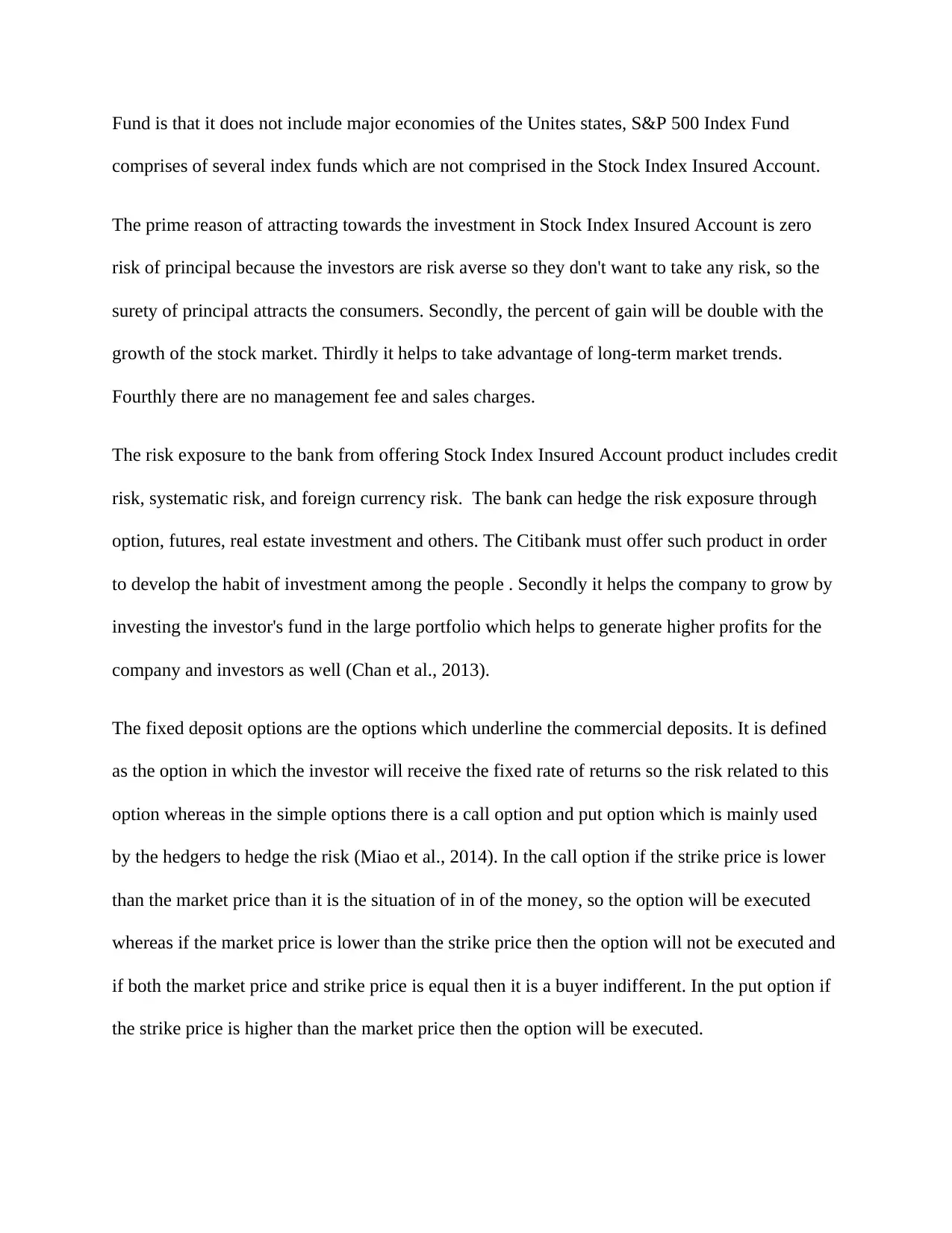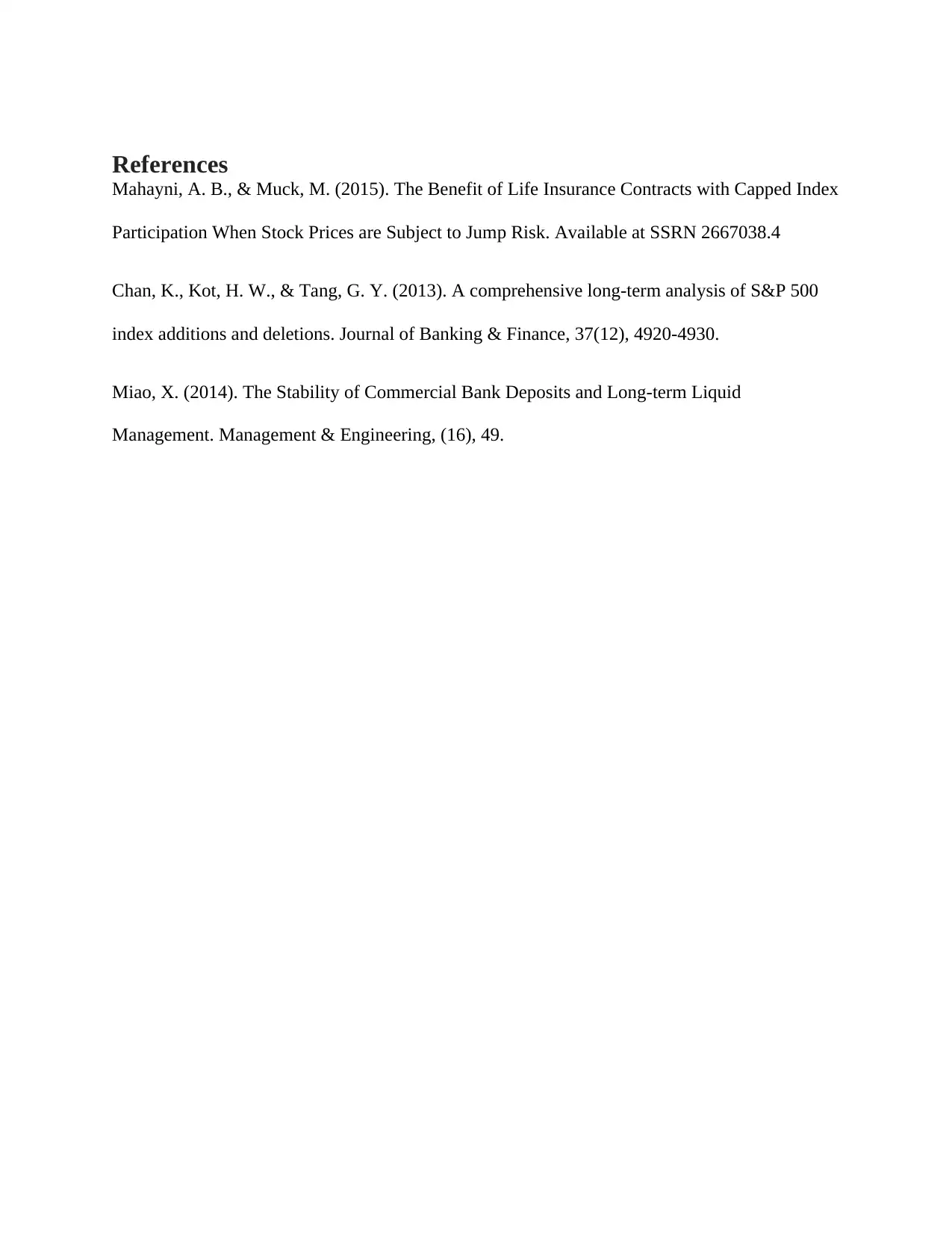Citibank Stock Index Investment Case Study: Financial Analysis
VerifiedAdded on 2019/10/08
|4
|683
|298
Case Study
AI Summary
This case study examines Citibank's stock index investment product, focusing on its features, risks, and comparison with other investment options. The analysis covers the product's payoff, cost to investors, and a comparison with S&P 500 index funds and commercial deposits. It explores the reasons for investor interest, risk exposure, and the differences between options underlying commercial deposits and simplified options. The study highlights the benefits of zero-risk principal and the potential for high returns, while also addressing the bank's risk management strategies. References include Mahayni & Muck (2015), Chan, Kot, & Tang (2013), and Miao (2014).

Case Study
Paraphrase This Document
Need a fresh take? Get an instant paraphrase of this document with our AI Paraphraser

In this present paper, we will discuss the newspaper advertisement of Citibank in which the bank
promises for stock market returns with zero risk to principal. The paper describe the payoff to
the investor, cost of the investor, comparison of Stock Index Insured Account with S&P 500
index fund and commercial deposits, reason of interest in product, risk exposure in offering the
product, and difference between the option that truly underline the commercial deposit and
options with simplifies version (Mahayni et al., 2015).
The cost of buying the product is $10,000. The investors lose in investing stock index account as
compassion to the commercial deposits includes long-term investment of five years whereas the
commercial deposits have the range from one month to five years. The commercial deposits have
fixed returns because of fixed interest rate whereas in the investment of Stock Index Insured
Account the return is based on the stock market movement over the complete five years. The loss
of investing in Stock Index Insured Account as a comparison to investing in S&P 500 Index
promises for stock market returns with zero risk to principal. The paper describe the payoff to
the investor, cost of the investor, comparison of Stock Index Insured Account with S&P 500
index fund and commercial deposits, reason of interest in product, risk exposure in offering the
product, and difference between the option that truly underline the commercial deposit and
options with simplifies version (Mahayni et al., 2015).
The cost of buying the product is $10,000. The investors lose in investing stock index account as
compassion to the commercial deposits includes long-term investment of five years whereas the
commercial deposits have the range from one month to five years. The commercial deposits have
fixed returns because of fixed interest rate whereas in the investment of Stock Index Insured
Account the return is based on the stock market movement over the complete five years. The loss
of investing in Stock Index Insured Account as a comparison to investing in S&P 500 Index

Fund is that it does not include major economies of the Unites states, S&P 500 Index Fund
comprises of several index funds which are not comprised in the Stock Index Insured Account.
The prime reason of attracting towards the investment in Stock Index Insured Account is zero
risk of principal because the investors are risk averse so they don't want to take any risk, so the
surety of principal attracts the consumers. Secondly, the percent of gain will be double with the
growth of the stock market. Thirdly it helps to take advantage of long-term market trends.
Fourthly there are no management fee and sales charges.
The risk exposure to the bank from offering Stock Index Insured Account product includes credit
risk, systematic risk, and foreign currency risk. The bank can hedge the risk exposure through
option, futures, real estate investment and others. The Citibank must offer such product in order
to develop the habit of investment among the people . Secondly it helps the company to grow by
investing the investor's fund in the large portfolio which helps to generate higher profits for the
company and investors as well (Chan et al., 2013).
The fixed deposit options are the options which underline the commercial deposits. It is defined
as the option in which the investor will receive the fixed rate of returns so the risk related to this
option whereas in the simple options there is a call option and put option which is mainly used
by the hedgers to hedge the risk (Miao et al., 2014). In the call option if the strike price is lower
than the market price than it is the situation of in of the money, so the option will be executed
whereas if the market price is lower than the strike price then the option will not be executed and
if both the market price and strike price is equal then it is a buyer indifferent. In the put option if
the strike price is higher than the market price then the option will be executed.
comprises of several index funds which are not comprised in the Stock Index Insured Account.
The prime reason of attracting towards the investment in Stock Index Insured Account is zero
risk of principal because the investors are risk averse so they don't want to take any risk, so the
surety of principal attracts the consumers. Secondly, the percent of gain will be double with the
growth of the stock market. Thirdly it helps to take advantage of long-term market trends.
Fourthly there are no management fee and sales charges.
The risk exposure to the bank from offering Stock Index Insured Account product includes credit
risk, systematic risk, and foreign currency risk. The bank can hedge the risk exposure through
option, futures, real estate investment and others. The Citibank must offer such product in order
to develop the habit of investment among the people . Secondly it helps the company to grow by
investing the investor's fund in the large portfolio which helps to generate higher profits for the
company and investors as well (Chan et al., 2013).
The fixed deposit options are the options which underline the commercial deposits. It is defined
as the option in which the investor will receive the fixed rate of returns so the risk related to this
option whereas in the simple options there is a call option and put option which is mainly used
by the hedgers to hedge the risk (Miao et al., 2014). In the call option if the strike price is lower
than the market price than it is the situation of in of the money, so the option will be executed
whereas if the market price is lower than the strike price then the option will not be executed and
if both the market price and strike price is equal then it is a buyer indifferent. In the put option if
the strike price is higher than the market price then the option will be executed.
⊘ This is a preview!⊘
Do you want full access?
Subscribe today to unlock all pages.

Trusted by 1+ million students worldwide

References
Mahayni, A. B., & Muck, M. (2015). The Benefit of Life Insurance Contracts with Capped Index
Participation When Stock Prices are Subject to Jump Risk. Available at SSRN 2667038.4
Chan, K., Kot, H. W., & Tang, G. Y. (2013). A comprehensive long-term analysis of S&P 500
index additions and deletions. Journal of Banking & Finance, 37(12), 4920-4930.
Miao, X. (2014). The Stability of Commercial Bank Deposits and Long-term Liquid
Management. Management & Engineering, (16), 49.
Mahayni, A. B., & Muck, M. (2015). The Benefit of Life Insurance Contracts with Capped Index
Participation When Stock Prices are Subject to Jump Risk. Available at SSRN 2667038.4
Chan, K., Kot, H. W., & Tang, G. Y. (2013). A comprehensive long-term analysis of S&P 500
index additions and deletions. Journal of Banking & Finance, 37(12), 4920-4930.
Miao, X. (2014). The Stability of Commercial Bank Deposits and Long-term Liquid
Management. Management & Engineering, (16), 49.
1 out of 4
Related Documents
Your All-in-One AI-Powered Toolkit for Academic Success.
+13062052269
info@desklib.com
Available 24*7 on WhatsApp / Email
![[object Object]](/_next/static/media/star-bottom.7253800d.svg)
Unlock your academic potential
Copyright © 2020–2025 A2Z Services. All Rights Reserved. Developed and managed by ZUCOL.





